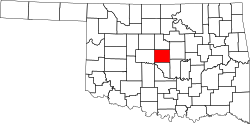Spencer, Oklahoma | |
|---|---|
 Location in Oklahoma County and the state of Oklahoma. | |
| Coordinates: 35°30′28″N97°22′14″W / 35.50778°N 97.37056°W | |
| Country | United States |
| State | Oklahoma |
| County | Oklahoma |
| Area | |
• Total | 5.38 sq mi (13.94 km2) |
| • Land | 5.38 sq mi (13.94 km2) |
| • Water | 0.00 sq mi (0.00 km2) |
| Elevation | 1,168 ft (356 m) |
| Population (2020) | |
• Total | 3,978 |
| • Density | 739.27/sq mi (285.42/km2) |
| Time zone | UTC-6 (Central (CST)) |
| • Summer (DST) | UTC-5 (CDT) |
| ZIP code | 73084 |
| Area code | 405 |
| FIPS code | 40-69200 [3] |
| GNIS feature ID | 2411952 [2] |
| Website | www |
Spencer is a city in Oklahoma County, Oklahoma, United States, and a part of the Oklahoma City metropolitan area. Its population was 3,978 at the 2020 census, a 1.7% increase from 2010.
Contents
- History
- Geography
- Demographics
- 2020 census
- 2000 census
- Education
- Dunjee School
- City embezzlement scandal
- References
- External links
Established in 1903, the City of Spencer is a historic community located just east of the North Canadian River. [4] Spencer is about 10 miles from downtown Oklahoma City and borders the cities of Nicoma Park to the east and Midwest City to the south.
Contributing to the cultural fabric of Spencer are the Spencer Chamber of Commerce, the Facebook page-Whats going on in Spencer Oklahoma, Spencer Senior Center, Spencer Parks Board, and the Spencer Historical Society. [4]
